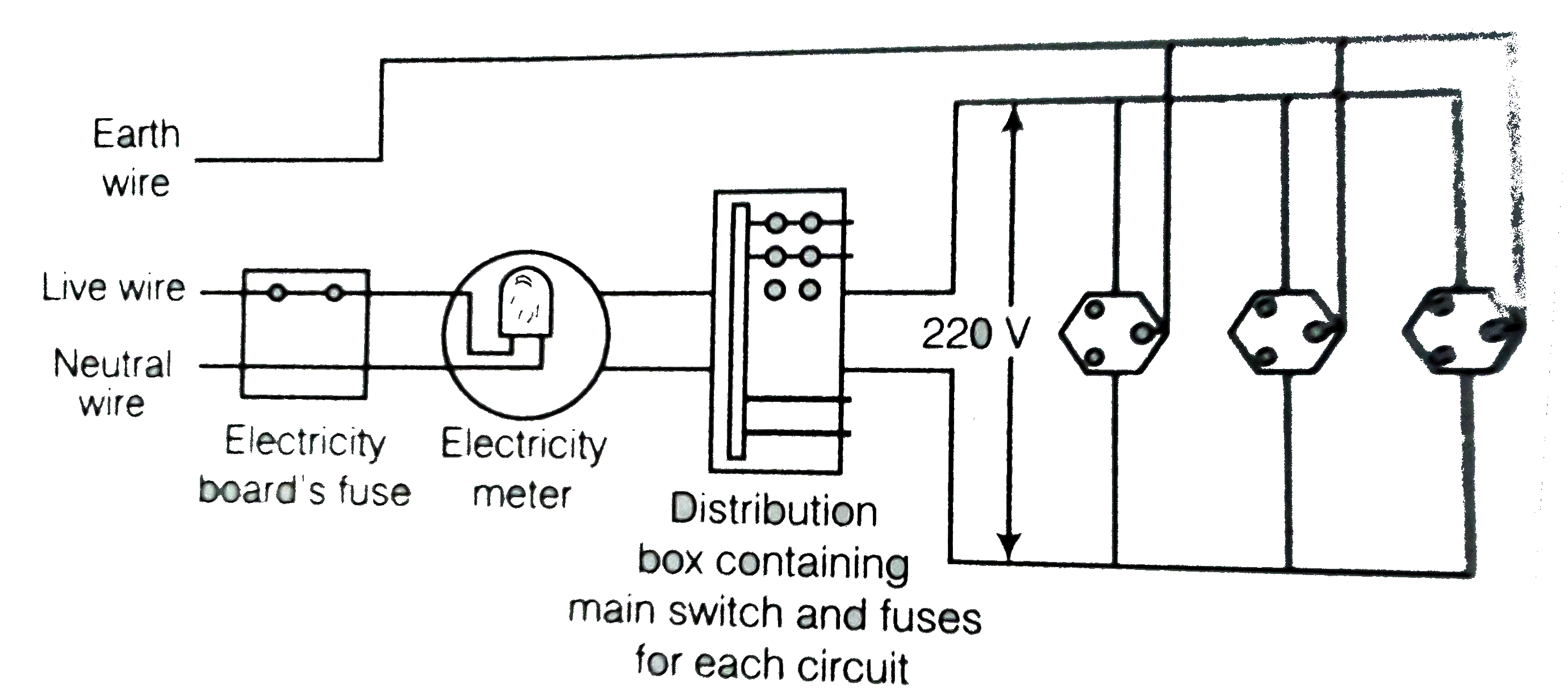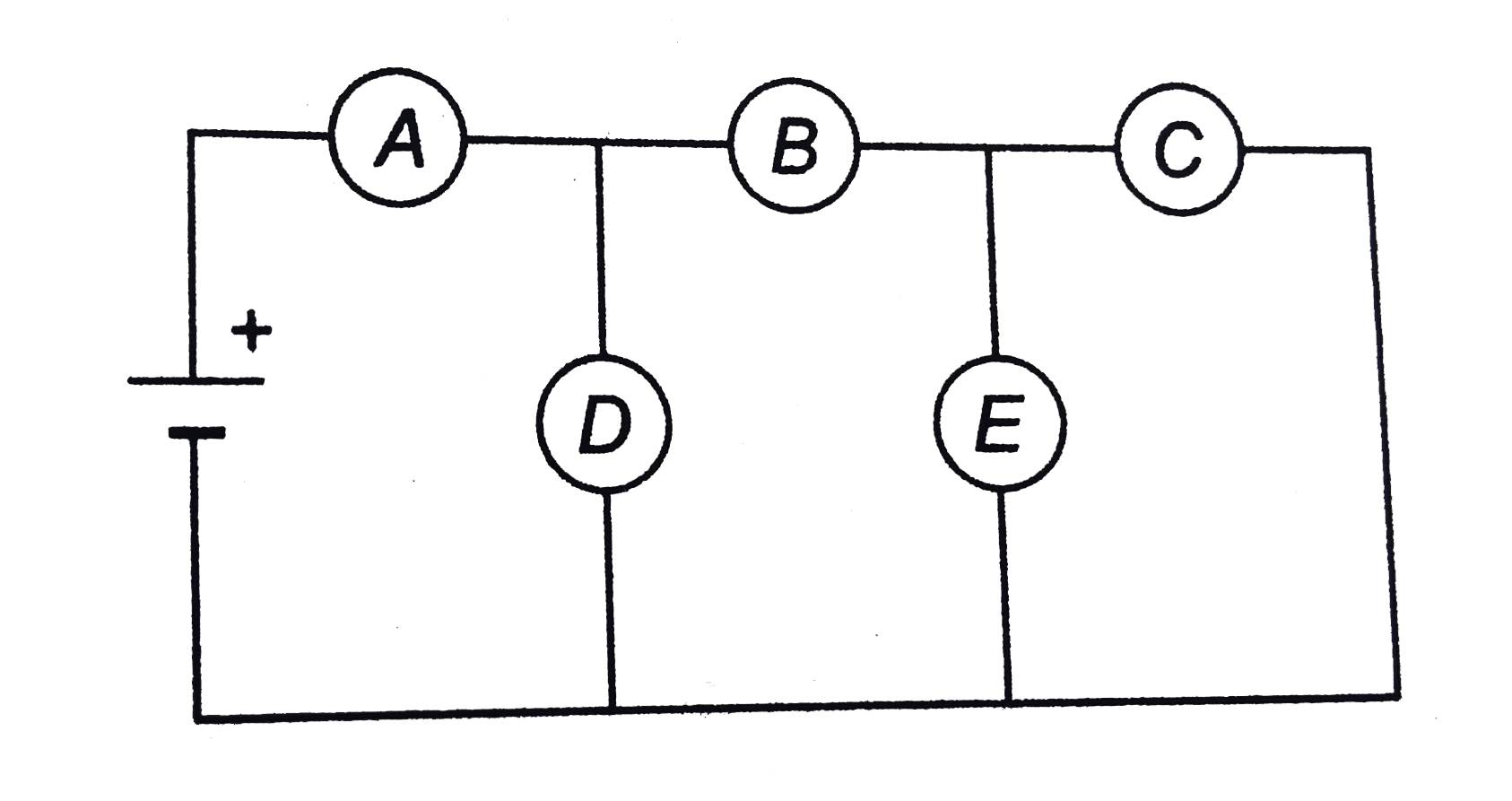Draw an appropriate schematic diagram showing common domestic circuits and discuss the importance of fuse. Why is it that a burnt out fuse should be replaced by another fuse of identical ratting?
The schematic diagram of common domestic circuit is shown below

Fuse is a safety device having short length of thic wire made of thin (25%) and lead (75%) alloy having low melting point around 200∘C. It is an important component of all domestic circuits. A fuse in a circuite prevents damage to the appliances and the circuit due to overloading and short-cicuiting. The use of an electric fuse prevents the electric and the appliance from a possibel damage by stopping the flow of unduly high electric current. The fuse is placed in series with the device.
A fuse wire works because of its lower melting point which is possible. If a fuse with larger rating is used with an appliance, the fuse, wire shall not melt and hence would fall to serve the required purpose. Due to this, a fuse with defined rating should not be replaced by one with a larger rating.
Topper's Solved these Questions
Similar Questions
Draw an appropriate schematic diagram showing common domestic circuits and discuss the importance of fuse. Why is it that a burnt out fuse should be replaced by another fuse of identical rating?
View SolutionDraw an appropriate schematic diagram showing common domestic circuits and discuss the importance of fuse. Why is it that a burnt out fuse should be replaced by another fuse of identical rating?
View Solution
Knowledge Check
- Question 1 - Select One
In the circuit diagram shown in figure, a fuse bulb can cause all other bulbs to go out. Identify the bulb
 ABBCCADD or E
ABBCCADD or E - Question 2 - Select One
Read the following passage carefully and answer the questions given below.
Two principles are involved in the controversy about the presence of foreign controlled media in the country. The free flow of ideas and images across national borders and the need to safeguard the national interest and preserve cultural autonomy. Both are valid but both are at loggerheads because each has been used to promote less lofty goals. The principle conforms to a moral imperative freedom of expression that cannot rhyme with restrictions imposed by any government. But the free flow rhetoric also clouds the fact that the powerful Western and specially American media can and often do present, subtly or brazenly, news in a manner which promotes Western political, ideological and strategic interests. Besides, Western entertainment programmes present lifestyles and values cherished by traditional societies. All this explains why so many Indian newspapers/magazines and news agencies have sought protection from the courts to prevent foreign publications and news agencies from operating in the country. Their arguments are weak on two counts. As the bitter debate on a new world information and communication order demonstrated in the late seventies and early eighties, many of those who resent Western 'invasion' in the information and cultural fields are no great friends of democracy. Secondly, the threat of such an 'invasion' has been aired by those media groups in the developing countries who fear that their business interests will be harmed if Western groups, equipped with large financial and technological resources and superior management skills are allowed to operate in the country without let.
The fear is valid but it goes against the grain of the economic reform programme. The presence of foreign newspapers and television channels will increase competition, which in course of time, can only lead to the upgradation of dynamic Indian newspapers and television channels even while they drive the rest out of the market. One way to strike a balance between the two antagonistic principles would be to allow foreign media entry into the country, provided the Indian state treats them at par with the domestic media on all fronts. On the import of technology, for instance foreign media cannot be allowed duty concessions denied to their Indian counterparts. Foreign media will also have to face the legal consequences should they run foul of Indian laws. Why, for example, should the BBC or Time magazine or The Economist get away with showing a map of Kashmir, which is at variance with the official Indian map? Why should they go scot-free when they allow secessionists and terrorists to air their views without giving the government the right of reply? Or when they depict sexually explicit scenes which would otherwise not be cleared by the Censor Board? Since the government can do precious little in the matter, especially about satellite broadcasts, what if it should consider attaching the properties of the offending parties? Demands of this kind are bound to be voiced unless New Delhi makes it clear to the foreign media that they will have to respect Indian susceptibilities especially where it concerns the country's integrity and its culture. It may be able to derive some inspiration from France's successful attempts in the recent GATT to protect its cinematographic industry.
Which of the following is one of the points weakening the argument of prevent entry of foreign media?AThe foreign media may not be treated on par with the domestic mediaBSuch entry would be against traditional cultureCThe arguments being put forth are at loggerheadsDThe threat being voiced by those whose business will be harmed by such an entry
Give reasons for the following:
The burnt out fuse should be replaced by another fuse of identical rating.View SolutionGive reasons for the following:
(i) There is either a convergence or a divergence of magnetic field lines near the ends of a current carrying straight solenoid.
(ii) The current carrying solenoid when suspended freely rests along particular direction.
(iii) The burnt out fuse should be replaced by another fuse of identical rating.View SolutionWhat is the role of fuse, used in series with any electrical appliance? Why should a fuse with defined rating not be replaced by one with a larger rating?
View SolutionWhat is the role of fuse used in series with any electrical appliasnce? Why should a fuse with defined rating not be replaced by one with a larger rating?
View SolutionWhat is the role of fuse used in series with any electrical appliasnce? Why should a fuse with defined rating not be replaced by one with a larger rating?
View Solution(a) Which is the better way to connect lights and other electrical appliances in domestic wiring: series circuits or parallel circuits? Why?
(b) Christmas tree lamps are usually wired in series. What happens if one lamp breaks?
(c) An electrician has wired a house in such a way that if a lamp gets fused in one room of the house, all the lamps in other rooms of the house stop working. What is the defect in the wiring?
(d) Draw a circuit diagram showing two electric lamps connected in parallel together with a cell and a switch that works both lamps. Mark an A on your diagram to show where an ammeter should be placed to measure the current.View Solution

